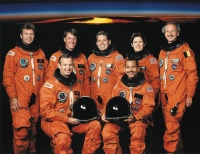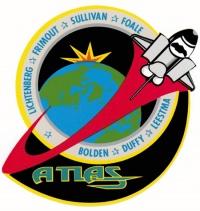STS-45
From The Space Library
 | |
| Organization | NASA-Office of Space Flight (United States) |
|---|---|
| Mission type | Astronomy,Human Crew,Solar Physics,Space Physics |
| Launch date | March 24, 1992 |
| Launch vehicle | Space Shuttle |
| Launch site | Cape Canaveral, United States |
| COSPAR ID | 1992-015A |
| Inclination | 57 degrees |
| Experiments | Here |
| Alternate Names | 21915 |
| Additional Information | Here |
| Data Collection | Here |
| Payload Mass Up | 8020 kg |
| Payload Mass Down | 8037.73 kg |
| Orbiter | Atlantis |
| Lift Off Mass | 2,043,652.27 kg |
| Orbiter Weight at Liftoff | 106,204.55 kg |
| Orbiter Weight at Landing | 93,200.91 kg |
| Landed | Concrete runway 33 at Kennedy Space Center, Fla. |
| Orbits of Earth | 143 |
| Orbital Altitude | 160 nautical miles (184 statute miles) |
Contents |
[edit] Crew
- Commander: Charles F. Bolden
- Pilot: Brian Duffy
- Payload Commander: Kathryn D. Sullivan
- Mission Specialist 1: David C. Leestma
- Mission Specialist 2: C. Michael Foale
- Mission Specialist 3:
- Mission Specialist 4:
- Mission Specialist 5:
- Payload Specialist 1: Dirk D. Frimout
- Payload Specialist 2: Byron K. Lichtenberg
ISS/Mir Crew Transport
[edit] Mission
The Space Shuttle ``Atlantis was a ten day mission primarily to operate the Atmospheric Laboratory for Applications and Science 1 (ATLAS 1) payload. ATLAS 1 (see entry) consisted of twelve instruments and thirteen experiments to study the Sun and Earth's atmosphere. Several more ATLAS flights are planned for studying solar inputs and atmospheric responses over an eleven year solar cycle. Additional payloads on the shuttle included the Shuttle Solar Backscatter Ultraviolet (SSBUV) (its fourth shuttle flight), and several Get Away Specials (GAS). Science experiment payloads included Space Tissue Loss (STL 1), an Investigations into Polymer Membrane Processing (IPMP) Experiment, the Shuttle Amateur Radio Experiment II (SAREX II), Visual Function Tester (VFT 2), Radiation Monitoring Equipment III (RME III), and the Cloud Logic to Optimize Use of Defense Systems (CLOUDS-1A) Experiment. The Shuttle flight carried a crew of seven, including three mission specialists and two payload specialists.
[edit] EVA
[edit] Payload
Atmospheric Laboratory for Applications and Science (ATLAS)-1; Shuttle Solar Backscatter Ultraviolet (SSBUV)-4; Getaway Special Experiment G-229; Space Tissue Loss (STL)-1; Radiation Monitoring Equipment (RME)-lIl; Visual Function Tester (VFT)-lI; Cloud Logic To Optimize Use of Defense Systems (CLOUDS)-1A; Investigations Into Polymer Membrane Processing (IPMP); Shuttle Amateur Radio Experiment (SAREX)-Il; Ultraviolet Plume Instrument (UVPl)
[edit] Books about the Space Shuttle Program
Buy This Book Click here |
Buy This Book here |
Buy This Book Click here |
Buy This Book Click here |





